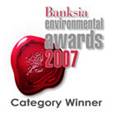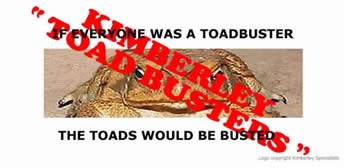Opinion
| “The solution to the cane toad invasion will be biological. Our State and Federal governments need to give much more urgent attention to the cane toad threat by increasing the funding for researchers looking into a biological solution. Volunteer groups in the field following the toad colonising fronts every week, removing toad biomass from systems, setting traps and undertaking fencing trials also need to be substantially funded while scientists are looking for a biological solution. Governments also need to fund scientists to work at the NT colonising fronts with the KTBs to ensure that scientists researching in the field have the benefit of the KTB insights developed working at this front, and finding out first hand what the KTBs know, and how and why we know what we know about cane toads! |
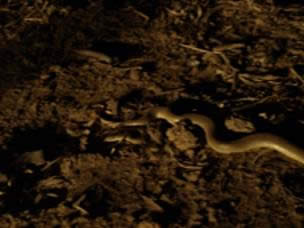
Snakes are extremely susceptible to cane toad poison. This snake lived on after the cane toad busters had removed cane toads from its habitat. |
Meanwhile, the KTBs will just keep toadbusting every weekend and looking for the answer while they are at it,” Lee Scott-Virtue 15 October 2007.
Premier in Kununurra to present KTBs with State funding
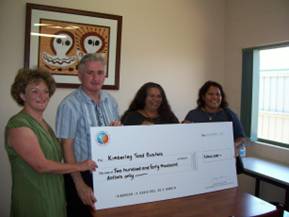
KTB Board Members, Mary Anne Winton and Sandy Boulter, receive cheque from Premier the Hon Alan Carpenter and the Hon Carol Martin |
On Friday 12 October, the Premier the Hon. Alan Carpenter attended the Kununurra office of the Hon. Carol Martin to present a cheque of $240,000 to the Kimberley Toad Busters from the State government. This is the first significant WA State government grant to the Kimberley Toad Busters. The money will be applied to recurrent field costs of toadbusting. It should cover most of the costs of one year of toadbusting at the present level of volunteer support. The KTBs welcome this recognition by the State government and look forward to continuing their successful award winning community campaign. Thank you to Carol Martin for her continued support for the KTB campaign. The KTBs look forward to the announcement by the State government of how the $150,000 set aside for an employed cane toad coordinator will be applied. |
Overview Field Report as at 31 October 2007
The Kimberley Toad Busters Field campaign now comprises two years and 5 weeks of consistent toad busting in the making. Despite 107 weekends of dedicated volunteer cane toad busting (and countless other week days) the colonising front (now identified as, at least, ten major corridors of activity) has moved over one hundred and seventy kilometres closer towards the Western Australian front and is now less than 80 km away on the Victoria Highway. |
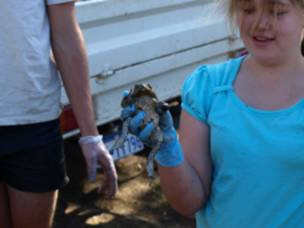
Junior toadbuster learning about safe handling of live cane toad |
Cane toads:
- have now entered Bulla River Station;
- are just into the Rooster system west of the Bulla River Road;
- just east of Googlie Holes along the Saddle Creek system;
- are now present at Limestone Gorge in the Gregory National Park;
- are in other areas of the Bullita limestone area; and
- are now just past the Humbert River Homestead.
The KTBs have made an impact on ‘slowing’ the number of toads now moving towards the Western Australian Border and the KTBs are confident they have identified all potential corridors of toads making their way towards Western Australian.
| Consistent toad busting by KTBs at this colonising front has now ensured that KTBs have a clear understanding of cane toad colonising behavior and can now better predict where and how breeding populations of toads will move across the landscape and what conditions will stimulate breeding. This information is invaluable for continually updating the KTB field strategy, which in turn ensures the Kimberley Communities will better deal with toads as they begin to make their way across the Kimberley/Northern Territory border. |
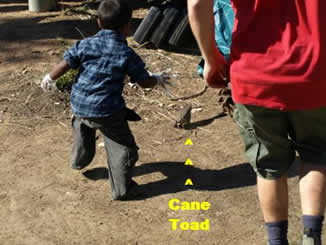
Junior toadbuster and the one that almost got away…
|
KTBs will continue to work through the 2007/08 wet season to ensure that any major breeding outbreaks in any of the ‘corridors’ are ‘hit’ immediately and also to ensure that we follow the pathways of the cane toad ‘corridors’ as they move in this upcoming wet season.
If you want to know how toadbusting really works, read this report from two of our regular and experienced toadbusters: Rooster Creek Toadbusting Reconnaissance Report: 26 – 28 th October 2007 by regular toadbusters: written by Donna Cavlovic who joined John Cugley on this toadbust.
“Following prior reconnaissance work, we made our way to the Rooster Creek Paddock on Auvergne Station. On the way, we checked the Turkey’s Nest a few kilometres past Bullo Station gate (off the highway on the left). We heard toads calling, which we hadn’t heard two weeks earlier. We collected 27 toads: mostly from the water. We bagged 3 more toads on our way to our campsite on Rooster Creek. We set up camp, had dinner and went to bed. Tomorrow was to be a big day.
“Saturday morning we woke up early and started our reconnaissance up Rooster Creek to locations we had GPS’d by helicopter 2 weeks ago. We noted that recent rain had created new puddles and waterholes, but none had any toad activity. After negotiating the maze of tributaries and steep banks, we located our main reference point T45, from which we removed approximately 400 tadpoles (there was no toad or toadlet activity seen here during the day). After half a day on the quad bikes in 40-degree heat we decided to head back to camp, checking water holes and puddles along the way. As the temperatures soared so did my allergy and I broke out in a complete body rash. This put me out for the afternoon, so I slept.
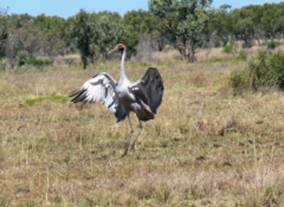 |
This Brolga, seen last week dancing just off the Duncan Highway from where cane toads are perhaps one wet season away, lives in wetlands favoured by cane toads. Brolgas are thought to mate for life. Their food includes fresh and saltwater invertebrates, and so brolgas may take cane toads in the early stages of the toads’ life cycle (being tadpoles and metamorphs), which will be poisonous to the Brolga. An en masse invasion of cane toads will also eat out or poison the brolgas’ food. |
“John checked out the spring at the jump-up towards Bullo Station. No toad activity was found. Once the sun had set and after dinner, John re-visited the Turkeys Nest and bagged another 31 toads. He noted that the pan on the left side (closest to the road) had the most toads collected that night. After dinner, we took the quad bikes out and made our way along side the highway towards Kununurra checking every culvert, creek and puddle for toad activity. No activity was found until a dam on the southern side of the highway (1 km east of Googlie Holes) where we bagged a total of 18 toads, most of which were amplexing. We returned back to camp stopping one last time at the Turkeys Nest were we collected a further 13 toads.
“By 3am we decided to head back to camp and get some more sleep.
“On waking, we packed up our gear and headed back towards Saddle Creek and Desmond’s Passage to look for a quicker way up the headwaters of Rooster Creek. We located a gate and parked the cars to set off on the quads before it got too hot. The terrain was rocky but we made good time. We found no activity in the small puddle at the headwaters of Rooster Creek.
“We returned to the vehicles to make our way home with all objectives achieved. Further toadbuster visits to the Googlie Holes area and Turkeys Nest on Bullo Station Road should be planned soon!”
Australian Conservation Volunteers Return To Toadbusting
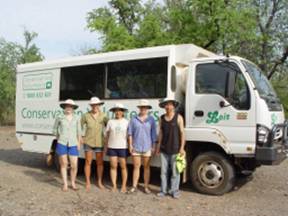 |
KTB toadbuster leaders Ronnie Atkins and Juju Wilson led a team of Australian Conservation Volunteers out toadbusting for three days 30 October – 1 November. What a wonderful and enthusiastic group! This truly international group led by Mike, the ACV Coordinator, and Jules, the ACV Driver and Team leader, included people from Germany, Ireland, England, Sydney, Broome, Thailand and China. |
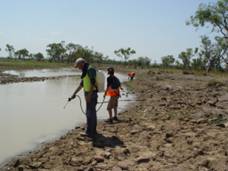 |
After a four hour drive, our new toadbusters arrived in camp in 40 degree plus heat. The first day was spent at the King Billabong spraying and scooping tadpoles. Enthusiasm was maintained by Ronnie insisting on 15 minutes on, 15 minutes off, to cope with heat.
Once these tadpoles were disposed of, back to camp and a swim under the West Baines Bridge, with a good watch for crocodiles maintained!
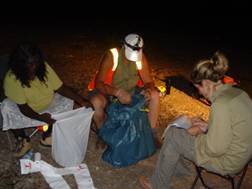 |
That night, the team was joined by experienced toadbuster Trevor Dutoit, who revelled in
having so many pairs of willing hands. Then it was on for one and all! After a moment’s hesitation ---? it was follow Trevor, in the dark, down the scrapes, into water and up to knees in mud, catching breeding cane toads, big fat females. Weighed down with a heavy torch, water bottle, and backpack – our Chinese volunteer emerged excitedly and with the greatest of satisfaction, with her handful of cane toads and then it was on for all! Trevor says all scrapes cleaned out and he was so grateful for the help. It was an early night on the first night - around 11.30 pm. |
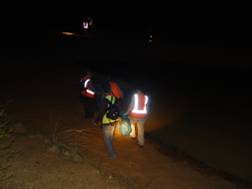 |
Day Two saw investigation of the Bullo Road roadside bores/turkey nest. Our volunteers were overawed by the amazing cattle country, the Pinkerton Ranges and just the fact that they were in this amazing Northern Australian country. We were just glad to have the help!
The Second Night’s busting was along the Snake Creek by overflows, where several toads were caught. It was noted that there is not much toad activity on the Victoria highway yet, because it is not quite wet enough. From King Billabong 60 adult cane toads (58 big males) were captured but no metamorphs were seen, revealing that this male colonising advance has now replaced the mixed cane toad population that was removed months earlier by the Vietnam Veterans’ team. It also shows that the Vietnam Veteran team had done a good job of cleaning out all the breeding toads from this site.
The ACV team caught 228 mature cane toads and ‘millions’ of tadpoles (still no metamorphs were to be seen). They saw an olive python up close and it, and many other of our native biodiversity, will live longer as a result of this toadbust.
Overheard from the ACV volunteers:
“Great stuff and I really get why we are doing this, now!”
“Keep up the good work!”
“Why did Queensland let it happen and why didn’t someone do something before it got to this?”
Thank you to the ACV for coming to help us again – you have made a difference and have now joined that elite club: you are Kimberley Toad Busters!
Ronnie Atkins is our First Paid Employee!
| To facilitate the Nicholson Station Duncan Highway expansion of the KSR/KTB cane toad campaign, the KTBs proudly announce the appointment of long time volunteer toadbuster, Ronnie Atkins as our first full time employee. Ronnie will share and grow the Field Campaign workload with Lee Scott-Virtue. Ronnie’s appointment is an interim three month position, while the KTBs seek funding for a permanent position at which time a permanent position will be advertised. |
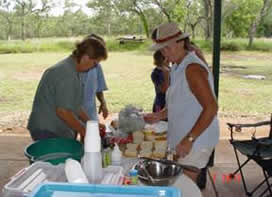
Lee Scott-Virtue and Ronnie Atkins making lunch for toadbusters out on a toadbust |
Ronnie will assist Lee with the Field Coordination and finally take some of the workload off Lee and Dean’s shoulders. Ronnie is learning the ropes and settling in well into her new position, and still putting in lots of volunteer hours as well! |
Is Toadbusting is a Waste of Time?
(KTB Response to the DEC/Peacock Report)
This is the KTB Preliminary Response to the DEC/Peacock Report.
(The KTBs are presently finalising their formal response to the DEC/Peacock report but believe it is important that a short response is provided, given the recent reporting in the media about the DEC/Peacock findings)
KTBs are Slowing Toads and Mitigating their Impacts (as per KTB Strategy)
It is NOT the KTB position that toadbusting is only about stopping the cane toads entering WA through the Kimberley. KTBs toadbust to slow the cane toad advance AND to mitigate the impact of the cane toad colonising front on our biodiversity. We do this by thinning the ranks of the advancing invasion and catching the big breeding toads at the forefront of the invasion. This means that fewer birds, fish and animals will be poisoned by toads, less food will be eaten by toads and fewer water holes will be polluted by toads (thereby reducing the likelihood of native species extinctions from the toad). The KTB campaign should mean that the Kimberley will only face toads filtering through to the Kimberley and Ord River catchment, rather than facing a surge en masse in millions decimating everything in its path. Stopping the toad altogether may be a dream but one can always dream… it’s over to the scientists to stop the toads…
- No Proof that Toads Being Slowed Down Means No Proof That They Are Not Being Slowed Down
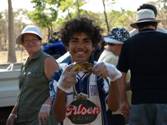 |
While there may be no proof to satisfy scientists that the KTBs have slowed the colonising front, there is also no proof that we have not slowed the advance of the cane toads, as we believe that we have. It should be noted that we have not had any of the cane toad research scientists working with us, or on our data, or in the field at the front. So scientists’ speculation about what is happening now at the western most edge of this colonising front is just that…speculation. The KTBs are happy to share their knowledge about this front and these colonising breeding toads with any visiting scientist willing to spend time getting on top of our data. KTBs have faced up to these toads every week for over 2 years GLOVED HAND ON TOAD ON TOAD. |
There is ONLY ONE CHANCE TO GET THIS DONE FOR THE KIMBERLEY AND IT IS NOW!
- The WA Cane Toad FIELD Campaign started for real at the Westward Moving Colonising Front following the Cane Toad Forum Organised by Kimberley Specialists in Research in April 2005
It was the initiative of Lee Scott-Virtue and Dean Goodgame through Kimberley Specialists in Research to hold a Cane Toad Forum in Kununurra in April 2005, which started off the Kimberley cane toad field campaign, described by Professor Peacock as a …social phenomenon. This forum, organised and funded by locals, suddenly raised the public profile of what was about to hit the Kimberley in terms of a cane toad invasion. It is the KTB Kununurra volunteers that have caused this truly remarkable and unique social phenomenon recognised by Professor Peacock in his report. (Over 30% of the entire population of Kununurra is a signed up toadbuster, comprising over 1,700 registered KTB volunteers).
- The KTB Field Strategy is to toadbust all year around in every corridor across the colonising front to catch as many of the breeding toads as possible and at the front lines, mop up as many eggs, tadpoles, metamorphs and toadlets as possible.
In a nutshell, this relies on an adaptive field strategy that responds to each new KTB (and DEC) report and data sheet, reconnaissance, targeted team placement, trained leaders, involvement of the indigenous community, education, making a record of our toad catches (weight, length and gender of each toad), recording abnormalities, and much much more…
- KTB field data shows that toadbusting is changing cane toad behaviour at the colonising front.
- KTB field data has led to a unique understanding of the how these westward moving toads go about colonising, and thus gives the KTBs good insights into how to best place the toadbusting teams.
- The KTB campaign has meant that the human communities ahead of the cane toad invasion are ready, educated and dangerous predators to cane toads.
These communities are ready to implement any proposal for eradication from scientists (or others), which the KTBs are satisfied might work.
- The KTB approach to the cane toad campaign is working, so if something is not broke let’s not try to fix it! KTBs consult, adapt and change as we go, and just keep getting better and better.
“ We’ve got one shot at this! If we are wrong but tried our best, we can live with that. If we could have made a difference and did not try, and find that out later, then that would be just too late and be truly awful! So let’s just get on with it ! ” Dean Goodgame of the Kimberley Toad Busters September 2007.
NB: The Kimberley Toad Busters were provided a copy of the DEC/ Peacock Report on 5 October 2007.
TO FENCE - OR NOT TO FENCE: Is that the Question?!
Turkey Nest Cane Toad Fencing
Not a Good Idea!
A fence around a man made water body that is not on a water course (Turkey Nest Dam – see below for further description), and which keeps out cane toads will also keep wildlife out of that water body and away from the water, which wildlife may need to survive the dry season. Many of these Turkey Nests have been so long a part of this landscape, they are found on maps. They now form part of the complex Kimberley ecosystems vital to the survival of our threatened biodiversity. A fence around a Turkey Nest Dam will simply deflect the cane toad to the water sources such as a water course or natural billabong where the cane toads are harder to control, and their offspring are harder to catch.
Field observations of the KTBs show that large adult breeding cane toads often appear to prefer Turkey Nests for Breeding. It is a reasonable hypothesis to test that these sites should be our preferred site for cane toads in terms of our biodiversity protection and toadbusting success, because they are contained and discrete, and not connected to the natural water systems (which are much harder to control because natural systems are larger, spreading and good corridors for cane toad invasions). Turkey Nests may also reduce the survival rate of the cane toad metamorphs because the food resources will be more limited in a discrete Turkey Nest environment.
Water Course Fencing
Not a Good Idea!
Cane toad eggs, tadpoles and toadlets will wash through a fence across a watercourse or across or around a dam on a watercourse. A fence across a water course is likely to wash away in a flood. Even if the fence does not wash away, in the wet season everything, including cane toad eggs, tadpoles, toadlets, metamorphs and adults will wash over the top of it or around it.
Landscape Fencing
Might Work but Cannot Stand Alone!
A fence across the landscape that traps cane toads will trap other wildlife that the KTBs seek to save from the cane toad. It will burn down in a fire (around 80% of the Kimberley landscape is burned every 2 years) or wash away in floodwaters (which occur each wet season). It will gather debris especially during floods, which will become a fire trap in the dry season.
If it is proposed that such a fence can deflect cane toads towards a trap, then this has not been shown to be successful.
The KTBs believe that if such a fence could be designed to successfully stop or deflect cane toads towards traps, it would require enormous and costly human monitoring, which would have to be continuous. This is because of the likely bi-catch of other animals, regular retrieval of cane toads from traps, weather impacts, maintenance, and general monitoring and data collection. Cattle and large animals are likely to damage a fence. Furthermore, many of the areas where toadbusting takes place are on cattle properties, where a fence may impede long standing cattle movements.
Trialling of a landscape fence needs to be in small discrete areas in corridors where there are natural barriers such as cliff faces, so that the fence acts as an adjunct to these natural barriers. Such a fence could only be of benefit if it were placed clearly ahead of the front line. The front line is scattered and often ill defined, and difficult to identify especially by anyone who is not regularly busting at the colonising fronts. Any trial barrier fencing has to be very carefully planned so as to catch adult toads before they breed, because a fence will not stop tadpoles, metamorphs and toadlets. For all the above reasons, barrier fencing can ONLY work to complement field hand catching by toadbusters in the field and cannot be left unattended for long.
Hessian Added to Existing Cattle Fences
Not a Good Idea!
An existing cattle fence that has hessian, or similar material attached, will catch debris, be a fire trap, and burn down. It will trap other wildlife that will die on the fence. It would be resource intensive to monitor and would require constant costly attention. Cattle fences so treated are less likely to survive and may require replacement/repair more often, thus placing a cost burden on the pastoral station owners who may then be less inclined to agree to and assist toadbuster entry onto their land.
Man made off water course water bodies – called Turkey Nests – contain water supplies in which water is stored (taken from bores, dams or natural water sources) and then supplied to troughs for watering, in this case cattle. These Turkey Nests are generally fenced to keep stock out, as otherwise the dam walls would disintegrate under hoof impacts. These water bodies often support native wildlife and are also perfect cane toad breeding habitats. Turkey Nests are mapped and this means that KTB volunteers know where they all are and can actively toadbust these on a regular basis according to the position of the front line cane toads as established by regular year round KTB reconnaissance. KTBs are currently experimenting with and investigating other methods of killing cane toads that have found their way to turkey nests and stopping breeding or killing off the offspring of the cane toads in these dams. Some chemicals have been shown to discourage cane toad breeding and the KTBs are exploring how this works with a view to investigating their application to toadbusting Turkey Nests.
These are man made water bodies that are built across water courses to catch the flow.
Nicholson Cane Toad Research Station

Cane Toad Research Station, Nicholson Station awaiting paint brush and lawn mower! |
The KTBs are delighted to announce a sponsorship of Kimberley Specialists in Research by Ord River Resources Ltd for the establishment of a Cane Toad Science Research Facility on Nicholson Station. Historic Nicholson Station is to be found on the Duncan Highway between Kununurra and the cane toads. Lee Scott – Virtue and Dean Goodgame will develop and run this Facility. Ord River Resources committed support for the KTB campaign has led to this exciting and most welcome initiative. The Duncan Highway crosses important river systems that will carry the cane toads from the Victoria River catchment to the Ord River catchment.
|
Our first scientist has been busy at the cane toad front. Lyall Grieve, from MacQuarie University NSW, has been studying cane toad impacts on small vertebrate animals.
WA CANE TOAD FIELD CAMPAIGN CHRONOLOGY 2003 - 2007
It is timely, given recent publications, to remind everyone and properly record the history of the WA based community cane toad campaign from the perspective of the Boards of KIMBERLEY SPECIALISTS IN RESEARCH INC and KIMBERLEY TOAD BUSTERS INC. If we have missed something please let us know.
The history of the Kimberley Toad Busters’
Field Campaign
October 2007 |
KTBs are announced as finalists in the 2007 WA Environment Awards and the 2007 Regional Achiever’s Awards. |
October 2007 |
STTF Toad Muster and Toad Fencing Trials on Whirlwind Plains, planned for 4 weeks. STTF granted $100,000 from WA government for Muster. |
September 2007 |
KTB Newsletter No 19 published
KTBs celebrate 2 years of weekly toadbusting
The Hon Kim Chance and Dept of Ag ensure that KTBs issued a licence to import dead cane toads for scientific and educational purposes
Number of media outlets and journals send representatives to toadbust
Recorded KTB Toad Tally is 140,642
KTBs major funding sources now amount as follows:
- Kimberley Specialists in Research $160,000 (and countless hours of in-kind contributions)
- Triple J $55,000 (and double this in in-kind contributions)
- Individual and business donations
- Federal Government: $373,011
- State Government: $60,000
- Biodiversity Protection WA: $125,000.
|
July 2007 |
- KTB newsletter No 18 published.
- KTBs finalists in three and winner of one category in the prestigious national environmental awards, the Banksia Environment Community of the Year Award.
- Bunbury Vietnam Veterans' team arrives for one month of toad busting.
- KTB website averaging 700 hits a day www.canetoads.com.au
- KTB recorded toad tally up to 117,821 (around 59,000 kgs of cane toad biomass).
- Groups involved in KTB campaign now include Wyndham Prison Camp, TAFE,CDEP, schools, Shire of Wyndham East Kimberley, DEC, Vietnam Veterans, Conservation Volunteers Australia, Triple J Tours, Nina’s Jewellery, Diversion Art Gallery Kununurra, Coles Kununurra, NT Parks and Wildlife, Kimberley Specialists in Research, Biodiversity Protection WA, Speliologists’ groups, Hotel Kununurra, and many more.
|
April 2007 |
- Wet Season KTB helicopter cane toad reconnaissance undertaken around Bullo River Station
- 10,000 KTB Educational Brochure, designed and written by KTBs and Friends of the KTBs based in Perth, and sponsored by Nina’s Jewellery, delivered to traveller and tourist outlets between Darwin and Kununurra
- Newsletter No 17 published
- Cane Toad Quiz Night fund raiser held in Kununurra raises around $4,500
- WA State government announces interim support for KTBs at $12,000 a month while DEC/Peacock Review and Report being written
- Numerous KTB education displays around Kununurra businesses
- Bob Cooper returns to Kununurra to hold bush survival courses for KTB field leaders
- Federal government grants $69,000 to buy second hand bus and trailer to transport large teams, including our junior toadbusters to the front
- Pearl donated by Nina’s Jewellery Kununurra donated for KTB raffle prize
|
February 2007 |
Kimberley Toad Busting has become a way of life for over 30% of Kununurra residents. They are now in their second wet season of toadbusting. For 20 months, the Kununurra based Kimberley Toad Busters have been in the field every weekend and increasingly with teams in the field on weekdays. They have toad busted over 60 sites – up to 450 kms from home - over an area of around 120,000 square kilometres. They have:
- caught 100,721 mature cane toads from the colonising front as at March 2007
- run a field campaign with safety of volunteers as a priority
- sponsored Bob Cooper Bush survival courses for KTB and DEC toad busters
- slowed the movement of the colonising front
- reduced the number of breeding toads at the front
- minimised the impact of the front on local fauna by preserving food resources
- liaised with the NT Parks and Wildlife, and the army for access to lands under their control, for access for toadbusting
- continued to educate and involve Northern Territory aboriginal communities and pastoral station managers in and around the colonising front about the complexity of the cane toad front and about cane toad behaviour and how to make a difference
- continued to develop the ongoing cane toad educational program in the Kimberley by setting up cane toad displays, talking at local schools and businesses and entering KTBs into various 2007 environmental and other volunteer awards.
- Continued to liaise closely with the scientists from around Australia conducting research on cane toads
- involved over 30% of the Kununurra community in toadbusting including indigenous and non-indigenous men, women and children and anticipate that this number will grow to 50% by the end of February
- involved tourists in toadbusting with the proposed release of 10,000 educational brochures encouraging visitors driving from the NT to WA to ‘pick-up’ toads.
- established cane toad trap making, educational and biodiversity survey programs in schools, TAFE and prison camps
- continued to involve indigenous communities in every step of the campaign
- established an indigenous hot line for cane toad finds
- established the support of DEC Kununurra, SWEK, many businesses and the federal government
- established support groups such as the Friends of the Kimberley Toad Busters based in Perth in Broome and Darwin
- Established on-going and new links with other volunteer groups throughout Australia wanting to set up cane toad fighting units
- ongoing bylines published in the Kimberley Echo.
- On-going advertorials and advertisements
The KTBs are ALL VOLUNTEERS and (other than $15,000 provided by CALM at a regional level in 2005 to Kimberley Specialists in Research for maintenance of the community website and field expenses incurred by volunteers traveling to the cane toad front) the KTBs have had no WA State government financial support..
The Federal Government support in June 2006 was opportune and assisted the community driven Kimberley Toad Busters to grow to the strength they have today. |
January 2007 |
Corrective Services developing Prison Camp Bob Cooper Safety Courses for toad busting. CS keen to get the Biodiversity Survey happening with the prisoners. |
2006 |
- KTB Winner of the 2006 Kleenheat Regional Community Year of the Year awards
- KTB Winner of the 2006 WA Environment Community of the Year award
- KTB Semi finalist in the 2006 WA Landcare Award
|
December 2006 14/12.06 |
Newsletter No 16 publishing all toadbusting results on website, by Kimberley Specialists.
Toadbusting continuously through Christmas New Year period. |
25 November 2006 |
Federal government registers the KTBs as a Registered Environmental organisation, thereby granting KTBs tax deductibility status. |
September 2006 |
Stop the Toad Foundation Toad Muster for 5 weeks based at Timber Creek Camp Grounds with toadbusting on Whirlwind Plains. |
September06
03/09/2006 |
Newsletter No 15 publishing all toadbusting results on website, by Kimberley Specialists. |
August 2006
09/08/2006 |
Newsletter No 14 publishing all toadbusting results on website, by Kimberley Specialists. |
April 2006
|
Newsletter No 13 publishing all toadbusting results on website, by Kimberley Specialists. |
March 2006
13/03.2006 |
Newsletter No 12 publishing all toadbusting results on website, by Kimberley Specialists. |
February 2006
10/02/2006 |
Newsletters No 10 and No 11 publishing all toadbusting results on website, by Kimberley Specialists.
KTB Friends School based cane toad education commences in Perth |
January 2006
07/01/2006 |
Obtained permission from Bradshaw Military base to toadbust on their land.
Newsletter No 9 published on website.
Perth based Friends of the Kimberley Toad Busters established. |
30December05 |
Kimberley Diamond Company sponsors Kimberley Toad Busters a freezer and Leaf Blower. |
24December05 |
No 8 Kimberley Toad Busters' Newsletter, publishing all toadbusting results on website, by Kimberley Specialists. |
22 -27 December 05 |
KTB volunteers continue to toad bust through Christmas. |
21December05 |
Lions Club offer insurance for Kimberley Toad Busters |
21December05 |
State Minister for the Environment the Honourable Dr Judy Edwards MLA attends Kununurra and hears about local concerns about STTF and listens to KSR power-point presentation on work of Kimberley Specialists and the Kimberley Toad Busters. Requests Lee Scott-Virtue to send Kimberley Toad Busting information directly to her. |
19 December05 |
Kimberley Toad Busters 7 th Echo bi-line published. |
17 – 18 December 2005 |
Toadbusting weekend. Kimberley Toad Busters traps made by Kimberley TAFE, Kununurra (materials/solar panels/lights donated by Biodiversity Protection Inc) was trialled for the first time. |
12 December 2005 |
Minister of Defence agrees to access to Bradshaw Military Base for Kimberley Toad Busters subject to conditions. |
12 December 2005 |
Local business Rogers Machinery commits sponsorship of a Fire Pump to Kimberley Toad Busters. |
12December05 |
6 th Kimberley Toad Busters Echo bi-line published. |
10-11 December 2005 |
Toad busting weekend. Kimberley Busters trialled Leaf Blowers and other equipment on Tadpoles and metamorphs. Triple J Tours donated 21 seater bus for permanent use by Kimberley Toad Busters. |
7 December 2005 |
Seventh Kimberley Toad Busters Newsletter published.
Kimberley Toad Busters Proposed Trapping Strategy published in newsletter. |
3-4 December 2005 |
Toadbusting weekend.
5 th Kimberley Toad Busters Echo bi-line published. |
29 November 2005 |
Sixth newsletter published.
4 th Kimberley Toad Busters Echo bi-line published. |
26-27 November 05 |
Training for Tourism operators at Victoria River Roadhouse, and volunteer cane toad busting activities all weekend. Almost 80 volunteers attended. |
22November05 |
$42,000 worth of urgently needed safety equipment donated to the KTBs and arrived in Kununurra from Biodiversity Protection Inc based in Perth |
23 November 2005 |
Kimberley TAFE Kununurra commenced manufacturing traps for Kimberley Toad Busters. |
19-20 November05 |
Toadbusting weekend |
21November05
|
4 th Kimberley Toad Busters Echo bi-line published. |
17 November 2005
|
Shire of Wyndham East Kimberley agrees to provide the Kimberley Specialists a 4W/D vehicle on a weekend basis for Kimberley Toad Busters. Cole’s Kununurra also offers the use of a 4W/D vehicle for some of their staff to use when ‘toad busting’. |
14November05 |
3 rd Kimberley Toad Busting Kimberley Echo bi-line published |
7 Nov 2005
|
2 nd Kimberley Toad Buster Echo Bi-line published. |
November05 |
Fifth KTB newsletter published. |
29-30 October 2005 |
Kimberley Specialists’ Kimberley Toad Busters educational training weekend
First Kimberley Toad Busting Kimberley Echo bi-line published |
27 October 2005 |
Fourth newsletter published. Local Newspaper offers a weekly Toad Busting update column to Kimberley Specialists. Lee Scott-Virtue to write the weekly account.
Kimberley Toad Busters Newsletters to be published in the Battye Library’s Electronic Publications.
Kimberley Toad Busters Newsletters to be published in the National Library’s “Pandora” electronic archives. |
22-23 October 2005 |
Kimberley Specialists Kimberley Toad Busters educational training weekend, including busting surveys by boats on Victoria River. |
18 October 2005
|
Third newsletter published.
Kimberley Toad Busters Field Strategy outlined in Newsletter. |
15-16 October 2005 |
Toadbusting and training weekend
|
5 October 2005 |
Commitment from CALM for support to Kimberley Specialists volunteer group. |
10 October 2005 |
Second Kimberley Specialists Kimberley Toad Busters Newsletter published.
Kimberley Specialists accepts CALM $10,000 offer of financial support to the Kimberley Toad Busting efforts. KS also accepted the CALM offer of $5,000 towards the KS maintenance of the Community Website. |
7 October 2005 |
STTF incorporated and registered as business. Business and Postal Address is registered as Conservation Council of WA. |
1 October 2005
|
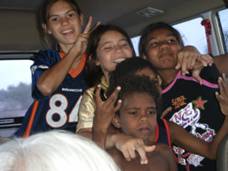
Junior Toadbusters on the KTB bus off to a toadbust |
Cane toad busting training and busting weekend at Fitzroy Community and Victoria River Roadhouse.
Stateline coverage organised by Kimberley Specialists. Timber Creek aboriginal elder, Elaine Watts involved in Fitzroy Community KTB toadbusting educational exercise and promises volunteer support for the KTB field campaign.
Big commitments from CDEP and TAFE aboriginal programs. |
|
27 September 2005
|
Kimberley Toad Busters Newsletters included in CALM’s Wildlife Science Library Collection.
CDEP coordinators set in train process for registering toad busting and trap making as a CDEP activity. |
20 September 2005 |
Kimberley Specialists discuss Insurance for their volunteers with CALM. A procedure set in place by CALM. |
17 September 2005 |
First Kimberley Specialists Kimberley Toad Busters Newsletter No. 1 published |
16 September 2005 |
Kimberley Specialists publish cane toad safety and trapping manual on their website |
10-11 September 2005 |
First Kimberley Toadbuster training and busting weekend with 90 volunteers.
Large indigenous commitment and presence, which has continued through all toad busts and training.
Cathy Freeman and Deborah Mailman attended. SBS coverage. |
31 July 2005 |
The period of preparation for the Kimberley Toad Busters’ Field Campaign
Premier announces $500,000 to be given to STTF on the basis that it is for on ground actions such as trapping,
"The representatives from Stop the Toad have demonstrated that they want to complement the State cane toad initiative with community involvement in 'on the ground' actions such as trapping.
"On that basis, the Government's commitment to increase funding for the program by a further $1million is a worthwhile investment in the State's lifestyle and environment.”
Premier Gallop |
4 June 2005 |
Perth Cane Toad Forum held by the Conservation Council of WA. |
24 May 2005 |
Conservation Council of WA makes decision to establish a separate and second cane toad body – called Stop The Toad Foundation – into which to direct the anticipated State government grant of $500,000 for community toadbusting. |
12 April 2005 |
Following on from the KSR Cane Toad Forum in Kununurra, the Federal Government declared cane toad a key threatening process to the Australian nation |
6 April 2005 |
WA State and Northern Territory governments funded cane toad trapping trials begin near Timber Creek and Victoria River Roadhouse in the NT |
19 – 20 March 2005 |
Kununurra Cane Toad Forum held in Kununurra facilitated, organised and partly sponsored by Kimberley Specialists in Research. After an approach from KSR, Dr Andrew Storey agreed to assist in the facilitation of academics to speak at the forum. Full sponsorship list is on community website.
Cane Toad Environmental Art Exhibition held.
KSR sponsorship paid for all speakers including Tim Winton (patron of STTF), Chris Tallentyre (Executive Officer CCWA), Russell Gueho (STTF Board member) and partner, to attend the Kununurra forum. |
19 – 29 November 2004 |
Community Website www.canetoads.com.au established and set up by donation of time, resources and expertise of Dean Goodgame of Kimberley Specialists. |
10 September 2004
|
Kimberley Specialists asked Triple J if they would contribute the ‘enviro/research’ levy towards the cost of the Cane Toad forum.
Kimberley Specialists sought further funding for proposed March Kununurra Cane Toad Forum. Triple J (local business) contributed $8,700 towards the organisational costs of the forum. |
1 March 2003
|
Kimberley Specialists in Research approached Triple J to see if they would be interested in putting in place an ‘enviro’ or ‘research’ levy to raise funds to sponsor research in the Kimberley. Triple J agreed to put in place $1 for every passenger carried.
Around this time KSR approached AgWA, CALM, Water and Rivers, SWEK and other government agencies to raise awareness of the impending invasion of cane toads of the East Kimberley. None of these local government agencies appeared to be aware of the cane toad threat, nor was anything being done about the threat. AgWA was then the first Kununurra based agency to then pick up on the cane toad threat. The community KSR cane toad forum was the first coordinated community outcome arising from the KSR agitation about the cane toad threat. |
If everyone was a toad buster, the toads would be busted!
ALL DONATIONS ARE TAX DEDUCTIBLE


|






